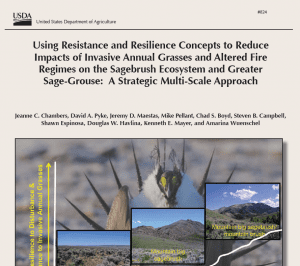Fuels & Fuel Treatments
View report.
This report provides a strategic approach for conservation of sagebrush ecosystems and greater sage-grouse that focuses specifically on habitat threats caused by invasive annual grasses and altered fire regimes. It uses information on (1) factors that influence sagebrush ecosystem resilience to disturbance and resistance to invasive annual grasses and (2) distribution, relative abundance, and persistence of sage-grouse populations to develop management strategies at both landscape and site scales.
View article.
In the op-ed piece, Two Wildfires Everyone Should be Talking About, Wally Covingtion director of the Ecological Restoration Institute and professor of forest ecology at Northern Arizona University, suggests that by acting quickly and at larger scales, forest health can be restored and resiliency be built so that forests are better prepared for whatever changes may occur in the future.
Visit SageSTEP website.
SageSTEP is a long-term multidisciplinary experiment evaluating methods of sagebrush steppe restoration in the Great Basin.
You can find and access information on this project’s:
- Land management treatments
- Treatment effects on vegetation and fuels; soils and biogeochemistry; water runoff and erosion; wildlife and insects
- The economics and human perspectives of management treatments
- Association with climate change
- Research findings thus far and project future
View report.
This is the final national report of the three-phased National Cohesive Wildland Fire Management Strategy development. The National Strategy includes a set of guidelines intended to provide basic direction when planning activities. Broadly defined to address national challenges, these guidelines can be tailored to meet local and regional needs
View report.
This report, developed by the Western Association of Fish and Wildlife Agencies (WAFWA), Wildfire and Invasive Species Initiative Working Group (Working Group), summarizes the current state of Fire Operations and Fuels management functions in big sagebrush communities. The intent of this report is to illustrate the type and responsiveness of efforts being made. Finally, the report concludes by presenting future options and a series of recommendations that may inform future policy and allocation decisions.
View synthesis.
This synthesis describes what is known about the cumulative impacts of historic livestock grazing patterns and short-term effects of livestock grazing on fuels and fire in sagebrush ecosystems. Over years and decades grazing can alter fuel characteristics of ecosystems. On a yearly basis, grazing can reduce the amount and alter the continuity of fine fuels, potentially changing wildlife fire spread and intensity. However, how grazing-induced fuel alterations affect wildland fire depends on weather conditions and plant community characteristics. As weather conditions become extreme, the influence of grazing on fire behavior is limited, especially in communities dominated by woody plants.
View synthesis.
This review of the literature found that in general long-term rest and modern properly managed grazing produce few significant differences. However, some topic areas have not been adequately studied to accurately predict the influence of long-term rest compared to managed grazing. In some situations, not grazing can cause an accumulation of fine fuels that increase fire risk and severity and, subsequently, the probability of sagebrush steppe rangelands converting to exotic annual grasslands. Shifts in plant communities (i.e., exotic annual grass invasion and western juniper encroachment), caused in part from historical improper grazing, cannot be reversed by long-term rest.
View report.
This review synthesizes the state of knowledge on fire effects on vegetation and soils in semi-arid ecosystems in the Great Basin Region. It identifies knowledge gaps and presents a framework for predicting plant successional trajectories following wild and prescribed fires and fire surrogate treatments. Possibly the three most important ecological site characteristics that influence a site’s resilience (ability of the ecological site to recover from disturbance) and resistance to invasive species are soil temperature/moisture regimes and the composition and structure of vegetation on the ecological site just prior to the disturbance event.
View abstracts.
Abstracts of recent papers on fire and fuels management in the West. Prepared by Craig Goodell, Fire Ecologist, USFS Pacific Northwest Region, Portland, OR.


